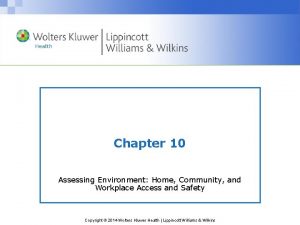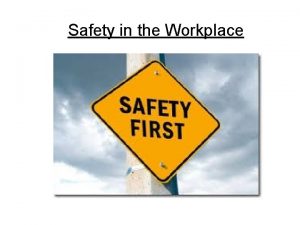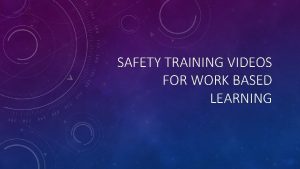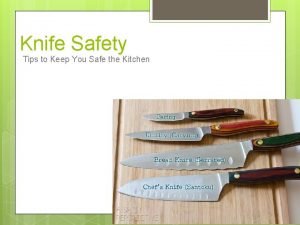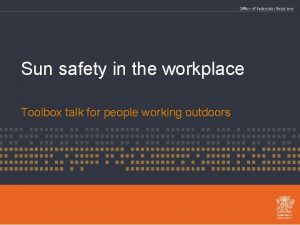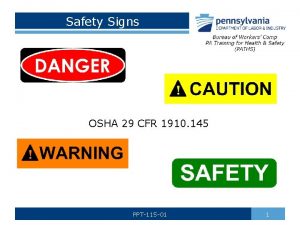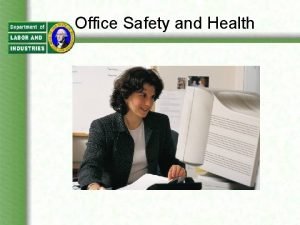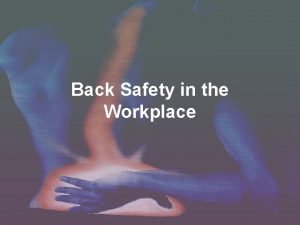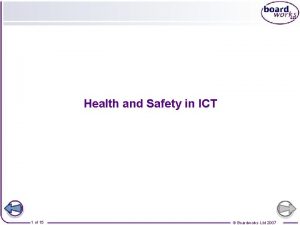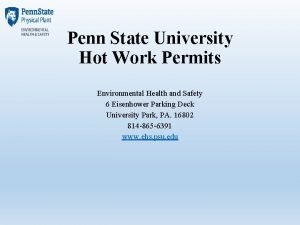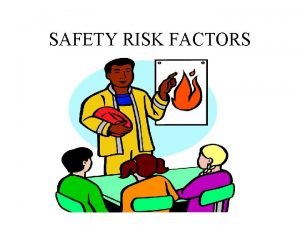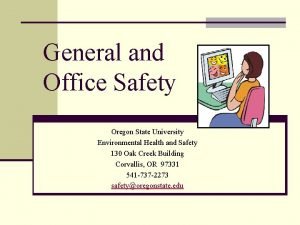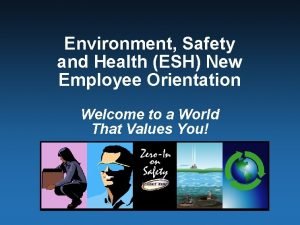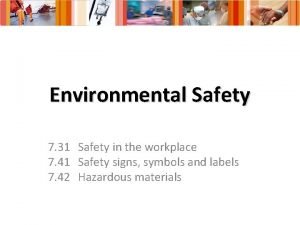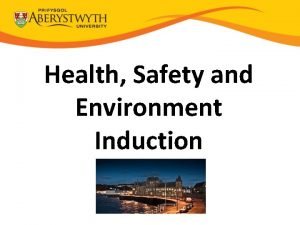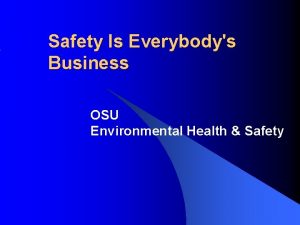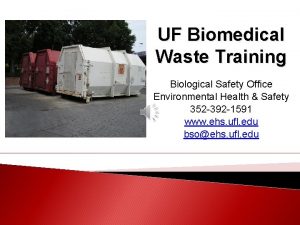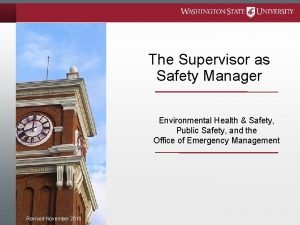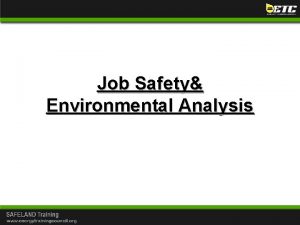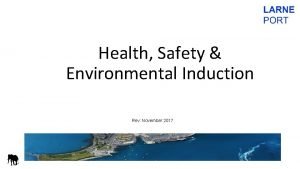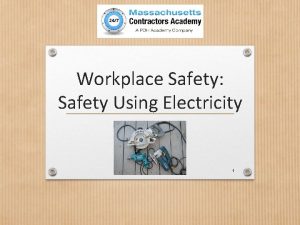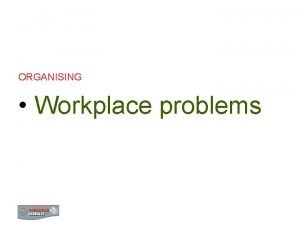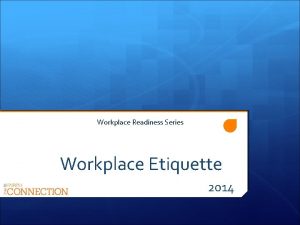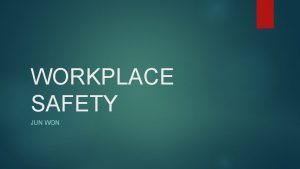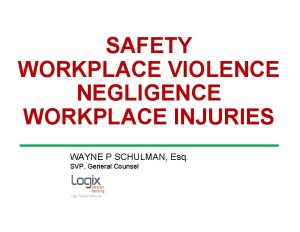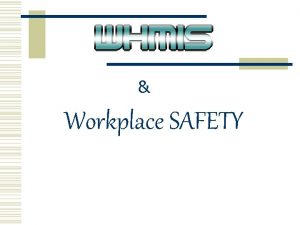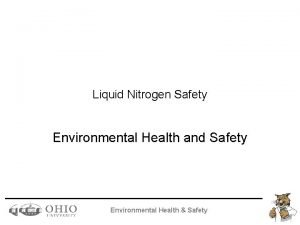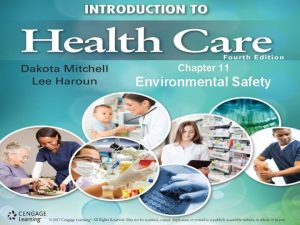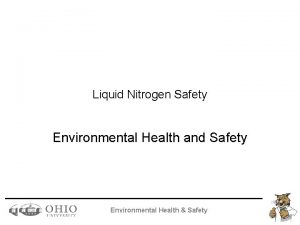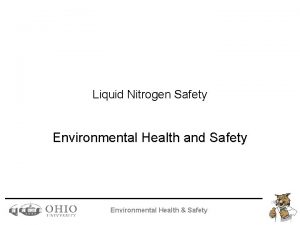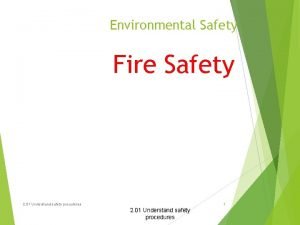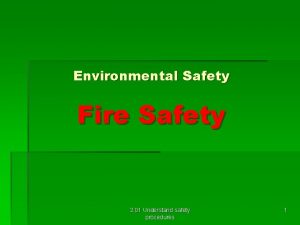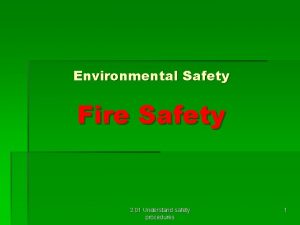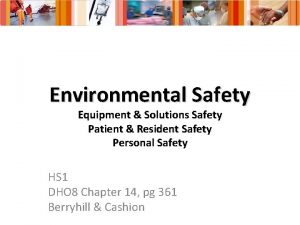Environmental Safety 7 31 Safety in the workplace



























- Slides: 27

Environmental Safety 7. 31 Safety in the workplace 7. 41 Safety signs, symbols and labels 7. 42 Hazardous materials

• Healthcare workers should have an awareness of the environment to prevent injuries. • It is our responsibility to report unsafe situations.

Equipment and Solutions • Read and follow operating instructions. • Report damaged or malfunctioning equipment immediately.

Equipment and Solutions • DO NOT use frayed or damaged electrical cords, or a plug with a broken prong. x

Equipment and Solutions • DO NOT handle electrical equipment with wet hands or around water. • Store all equipment in its proper place. • Read Material Safety Data Sheets before using chemicals.

Patient and Resident Safety • DO NOT perform procedures unless instructed to do so. • Use only correct and approved methods, never shortcuts. ****

Patient and Resident Safety • Provide patient privacy: 1. 2. 3. 4. Knock before entering the room. Speak to the patient and identify yourself. Ask for permission to go around a privacy curtain. Provide privacy before beginning a procedure.

Patient and Resident Safety • Identify the patient. 1. Check the ID band. 2. Ask the patient to state his or her name. 3. Address the patient by his or her name at least twice. • Explain what you are going to do. • Never perform a procedure if the patient refuses.

Patient and Resident Safety • Be alert to the patient’s condition at all times, and report any changes. • Be alert to environmental safety hazards. • Before leaving a patient, be sure: 1. 2. 3. 4. The bed is at its lowest level, wheels locked. The call bell is within reach. Supplies are within easy reach. To leave the area neat and clean.

Personal Safety • • Protect yourself and others from injury. Use correct body mechanics. Wear the required uniform. Walk – DO NOT run!

Personal Safety • Immediately report personal injury to your supervisor. • Report unsafe situations to your supervisor. • Keep areas clean and neat with everything in the proper place. • Wash hands frequently.

Personal Safety • Keep hands away from face, eyes and mouth. • Dry hands before touching equipment.

Personal Safety • If solutions get in your eyes, flush with water and inform your supervisor. • If a particle gets in your eye – inform your supervisor and DON’T rub it or try to remove the particle.

Signs and Symbols • Bio-hazard symbol

• • What does this symbol tell a healthcare worker? • • A. B. C. D. This is a poison Practice standard precautions This item is sterile Bloodborne pathogen alert

Signs and Symbols • Standard precaution symbols for: – Wash hands – Wear gloves – Wear mask – Wear eye protection – Wear gown

Handwashing 1. Regular handwashing is the MOST important practice for aseptic technique. 2. Ingredients = plain soap and water 3. Use regular handwashing for routine cleansing and whenever the hands are visibly soiled. 4. According to the CDC, “Handwashing is a simple thing and it's the best way to prevent infection and illness. ”

When should you wash your hands? 1. When arriving at and before leaving a healthcare facility. 2. Before and after every patient contact. 3. Before moving from a contaminated body site to a clean body site. 4. Any time hands become contaminated during a procedure. 5. Before applying and immediately after removing gloves.

When should you wash your hands? Cont. 6. Any time gloves are torn or punctured. 7. Before and after handling specimens. 8. After picking up an item off the floor. 9. After personal use of the bathroom. 10. After you cough, sneeze, or use a tissue. 11. Before or after any contact with your mouth or mucous membrane (eating, drinking, inserting contacts, etc. )

Antiseptic Handrubs • Alcohol-based • Use when hands are not visibly soiled

PPE Personal Protective Equipment • • Gowns Gloves Mask Protective eye ware

• For breakage or spills, notify your supervisor immediately and follow disposal instructions on the label or MSDS.

General Fire Safety ïKeep maintenance and storage areas clean and free of trash, sawdust, oily rags, etc. ïKeep halls and stairways clear. ïBe sure that EXIT signs are always lighted and that emergency lighting is in working order.

General Fire Safety ïKeep combustibles away from heat producing devices. ïPrevent sparks in patient areas where oxygen is used.

Oxygen use • NO SMOKING-OXYGEN IN USE Sign on patients door • Keep tubing free of kinks and prevent falls • Monitor any electrical devices in patients room

RACE R A C E Remove all patients or personnel in the immediate vicinity of the fire Activate the alarm and notify Contain the fire and smoke by closing all doors in the area Extinguish the fire

Using a portable fire extinguisher: PASS • Keep your back to the exit and stand 10 -20 feet away from the fire • P-Pull the pin • A-Aim low • S-Squeeze from • S- side to side
 Workplace environmental assessment
Workplace environmental assessment Wireless health
Wireless health Workplace safety vocabulary
Workplace safety vocabulary Osha training videos
Osha training videos Knife safety tips
Knife safety tips Chapter 10 workplace safety procedures
Chapter 10 workplace safety procedures Toolbox talk sun safety
Toolbox talk sun safety Accident prevention signs and tags training ppt
Accident prevention signs and tags training ppt Hazard
Hazard Back safety in the workplace
Back safety in the workplace Ict workplace health and safety
Ict workplace health and safety Ehs psu
Ehs psu Portal of entry
Portal of entry Ehs oregon state
Ehs oregon state Esh environmental safety health
Esh environmental safety health Environmental safety
Environmental safety No work prior to safety/environmental induction sign
No work prior to safety/environmental induction sign Osu environmental health and safety
Osu environmental health and safety Uf bloodborne pathogen training
Uf bloodborne pathogen training Wsu environmental health and safety
Wsu environmental health and safety Job safety and environmental analysis
Job safety and environmental analysis No work prior to safety/environmental induction sign
No work prior to safety/environmental induction sign Từ ngữ thể hiện lòng nhân hậu
Từ ngữ thể hiện lòng nhân hậu Sự nuôi và dạy con của hươu
Sự nuôi và dạy con của hươu Vẽ hình chiếu vuông góc của vật thể sau
Vẽ hình chiếu vuông góc của vật thể sau Diễn thế sinh thái là
Diễn thế sinh thái là 101012 bằng
101012 bằng Tỉ lệ cơ thể trẻ em
Tỉ lệ cơ thể trẻ em
